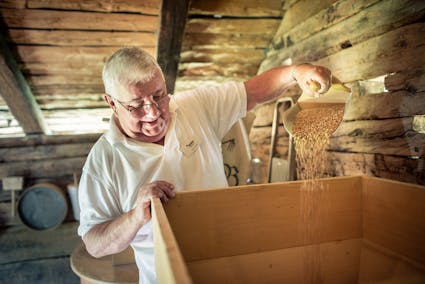Milling
Bread and, naturally therefore, flour played a central role in the everyday life of the rural population in former times. The ingenious old water wheel mills still bear witness to those times today. The Mill from Törbel VS (1121) in the Ballenberg Open-Air Museum demonstrates how the milling process worked. It is a so-called “Stockmühle”, that is to say, it has a vertical shaft and a horizontal wheel. This type of mill was less common than the water mills with a vertical wheel.

Spectacle of engineering
When the mill is working it puts on a display of real engineering. A hollowed-out tree trunk behind the building catches the water as it cascades down, just like the pressure pipe in a power station, and guides it into the cellar. There it is directed in two jets straight onto the two horizontal water wheels and the axles of the wheels transmit the power to the runner millstone in the upper storey.
Stories about bread
The Mill from Törbel stood by a stream not far from the village, together with other mills, a fulling mill and a saw mill. How the families went about making the vital loaves of rye bread is a story in itself, and visitors can read all about it in the mill under the subject heading “Grain and Bread”.
The flour that is milled nowadays in the museum is a mixture of spelt and wheat, and is on sale in the mill, in the Dwelling from Blatten (1111), in the Märithüsli at the Eastern entrance and in the Farmhouse from Ostermundigen (331).
Ballenberg
Swiss Open-Air Museum
Museumsstrasse 100
CH-3858 Hofstetten bei Brienz
Opening hours
10 April to 2 November 2025
10 am to 5 pm daily